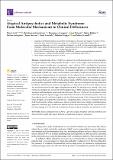Atypical antipsychotics and metabolic syndrome : from molecular mechanisms to clinical differences
Abstract
Atypical antipsychotics (AAPs) are commonly prescribed medications to treat schizophre-nia, bipolar disorders and other psychotic disorders. However, they might cause metabolic syndrome (MetS) in terms of weight gain, dyslipidemia, type 2 diabetes (T2D), and high blood pressure, which are responsible for reduced life expectancy and poor adherence. Importantly, there is clear evidence that early metabolic disturbances can precede weight gain, even if the latter still remains the hallmark of AAPs use. In fact, AAPs interfere profoundly with glucose and lipid homeostasis acting mostly on hypothalamus, liver, pancreatic β-cells, adipose tissue, and skeletal muscle. Their ac-tions on hypothalamic centers via dopamine, serotonin, acetylcholine, and histamine receptors affect neuropeptides and 5′ AMP-activated protein kinase (AMPK) activity, thus producing a supra-physiological sympathetic outflow augmenting levels of glucagon and hepatic glucose production. In addition, altered insulin secretion, dyslipidemia, fat deposition in the liver and adipose tissues, and insulin resistance become aggravating factors for MetS. In clinical practice, among AAPs, olan-zapine and clozapine are associated with the highest risk of MetS, whereas quetiapine, risperidone, asenapine and amisulpride cause moderate alterations. The new AAPs such as ziprasidone, lurasi-done and the partial agonist aripiprazole seem more tolerable on the metabolic profile. However, these aspects must be considered together with the differences among AAPs in terms of their efficacy, where clozapine still remains the most effective. Intriguingly, there seems to be a correlation between AAP’s higher clinical efficacy and increase risk of metabolic alterations. Finally, a multidisciplinary approach combining psychoeducation and therapeutic drug monitoring (TDM) is proposed as a first-line strategy to avoid the MetS. In addition, pharmacological treatments are discussed as well.
Citation
Carli , M , Kolachalam , S , Longoni , B , Pintaudi , A , Baldini , M , Aringhieri , S , Fasciani , I , Annibale , P , Maggio , R & Scarselli , M 2021 , ' Atypical antipsychotics and metabolic syndrome : from molecular mechanisms to clinical differences ' , Pharmaceuticals , vol. 14 , no. 3 , 238 . https://doi.org/10.3390/ph14030238
Publication
Pharmaceuticals
Status
Peer reviewed
ISSN
1424-8247Type
Journal item
Collections
Items in the St Andrews Research Repository are protected by copyright, with all rights reserved, unless otherwise indicated.

